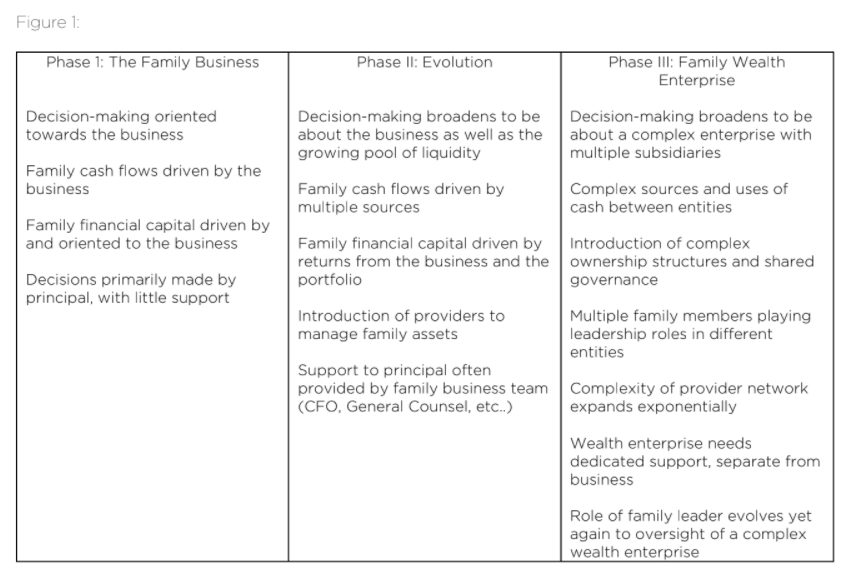Succession planning is critical for effective wealth transitions within a family wealth enterprise. One aspect of succession planning that is often overlooked, and impacts both the short- and the long-term success of the family enterprise, is role transition.
Specifically, the role transition that occurs between the current decision-maker and the next family enterprise CEO, when it isn’t the next generation taking over. Understanding this vital shift in leadership will allow families to transition more seamlessly and with the least amount of stress.
How Wealth Transfers Take Place
The practical aspects of wealth transfers form the basis for a smooth movement of wealth between parties, at least in the short term. Within this, wealth managers undertake several important tasks. Namely:
- Investment strategy
- Tax optimisation
- Estate planning and structuring
Naturally, these are imperative processes to complete, however, they are only part of the picture. For long-term sustainability, role transition needs to be examined alongside these wealth transfer tasks.
Role Transitions Are About More Than The Next Generation
In this context, when discussing role transition within a family enterprise, we are considering the transition of leadership from the current decision-maker, the CEO of the family wealth, to the next. Often the focus is on the transition to the next generation of the family who are expected to, and are being trained to, take over the leadership. But this overlooks a fundamental role transition that takes place in the leadership when a new decision-maker is needed before the next generation is ready to assume their role.
This new leadership is often forced because a decision-maker is unexpectedly lost, perhaps due to sudden death or incapacitation, and so a partner or adjacent family member is called on to become the new decision-maker. This comes with unique challenges as this person, such as the husband or wife to the original decision-maker, is required to move into the new role after having been uninvolved in the family enterprise for a significant time. As a result, the new decision-maker has to be brought up to speed in a much shorter amount of time than would be ideal. This is no easy feat, even with wealth managers on hand to support them.
An Example Of Role Transition (Before The Next Generation Assumes Leadership)
Though every family’s wealth enterprise journey is unique, the ways that the leadership role develops, and the snag that appears when a new decision-maker is unexpectedly required, are commonplace. The typical steps of this journey are:
Founding The Family Wealth Enterprise
Over a number of decades, a family business manages to achieve financial success. This leads them to create a family wealth enterprise and assign the roles within the family to the wealth enterprise, such as CEO and CFO, as needed.
Growth Of The Wealth Enterprise
Over time, the nature of the family wealth enterprise changes. Under the decision-maker’s leadership, the complexity of the wealth enterprise develops and increases. As a result, and importantly when it comes to the role transition later on, the role and focus of the decision-maker changes in significant ways. This can be summarised as follows:

Figure 1
Progression Of The Leadership Role
During the time of wealth development, the division of labour between the primary decision-maker and their partner becomes clearer and each assumes full autonomy in their lane.
The person who has become the decision-maker becomes the CEO of the family wealth enterprise. They develop skills in executive decision making while getting to grips with the complex ins-and-outs of the family financials. Their confidence grows too, rooting them in the leadership role. Meanwhile, the decision-maker’s partner focuses on their own interests, such as career, family or community, in parallel.
The natural growth of the family liquidity leads to the decision-maker hiring outside experts and providers to support them in the management of the family wealth, across core areas like: taxes, estate planning and investments.
This development and growth of the family wealth enterprise team allows the decision-maker’s partner to feel secure in the choices of the decision-maker, which in turn enables the decision-maker’s leadership to thrive with little input required from them. This can continue for many years.
The Break In The Family Wealth Enterprise’s Leadership
When the decision-maker’s ability to continue in their leadership role abruptly ends, this creates a void in the leadership role. Typically this void is caused by one of three circumstances:
- Incapacitation of the decision-maker
- The decision-maker’s sudden passing
- Separation from the decision maker – such as by divorce or civil partnership dissolution
This change requires the non-decision maker to undertake a role transition into the leadership position. As described, this is a serious undertaking due to the complexity of the wealth enterprise, which has grown over time. Plus, there are the emotional ramifications of the void-causing events that the new decision-maker will be dealing with. Getting the new decision-maker into a position to confidently take on the leadership role is where advisors add even more significant value.
How Wealth Management Advisors Assist In Leadership Transitions
During a role transition, wealth management advisors can help prepare the new decision-maker for their new role, easing their transition from beneficiary of the family wealth to its primary decision-maker. We do this while imparting the kind of nuanced understanding of the wealth enterprise that the new decision-maker needs, and the former decision-maker had gathered over their years in the role.
Wealth management support during the period of role transition can be broken down into three areas: wealth mapping, a new plan for new leadership and establishment of a decision-making process.
Wealth Mapping
Mapping in this context comprises the examination of three critical components of the wealth enterprise:
- Sources and uses of cash
- Assets and liabilities
- Governance and decision-making rights
Often, mapping is overlooked during the role transition as it is not where the new decision-maker’s, or even the wealth manager’s, focus would have been prior to the leadership void. Mapping the critical components of the wealth enterprise typically takes place at the start of the family business. As the family enterprise grew, it would only continue to exist, if at all, in the mind of the original decision-maker. It would be unlikely that the mapping was written down in any form.
Once the new decision-maker is in place, they will frequently aim to mirror the actions of their predecessor. However, this will be highly execution orientated, such as:
- The minutiae of investing – for example: which stocks to buy, the merits of particular investments or worth of certain securities
- The details of tax planning
- The complexities of estate planning structures
These actions lack an overview of the wealth – something that cannot be achieved without clear wealth mapping – and therefore aren’t necessarily the best actions to take for the wealth enterprise.
With wealth mapping, the new decision-maker will become more informed, which will grow their confidence in their new role. It will help them identify misalignments and imbalances, offer an overarching framework and clarify the priorities for their decision-making going forward.
During the mapping process, wealth management advisors can assist by focusing on the day-to-day activities, ensuring the family enterprise continues to function effectively.
A New Plan For New Leadership
Following wealth mapping, the new decision-maker, alongside the wealth managers, can develop a new plan for the wealth enterprise. Within this new plan for the new leadership should be the answers to the following key questions:
- What’s the big picture plan?
- What are the priorities?
- What is the purpose of the wealth?
- How long will the wealth last?
- Do I/we have enough?
- Is the ultimate disposition of the assets (taxes, charity, children and grandchildren) what I want?
- Do I have the right set of providers?
- Is the portfolio aligned with my needs?
- What are the highest priorities that require immediate attention?
Establishing A Decision-Making Process
Alongside the new plan for the new leadership, the new decision-maker and wealth management advisors should look at the development of an on-going decision-making process. In order to complete this effectively and create a valuable process for the new leadership, the following critical questions should be answered:
- How often will the family meet to make decisions?
- Who are the key decision makers and what are their rights?
- Who will help the family manage and execute the process?
- How and when should the family bring in key providers (lawyers, accountants, investment managers) into the process?
- What kind of information and reporting will the family need to make decisions and who will provide it?
- How will the family define and measure success?
- How will the family engage different stakeholders in the process to facilitate learning and engagement?
Role Transition Needs To Be Part Of The Ongoing Strategy
With all these areas covered, the new decision-maker will be well on their way to creating long-term success for the family wealth enterprise. To avoid the difficulties of leadership void and role transition, leadership transition planning should be made a part of the ongoing family wealth enterprise strategy.
Being able to step confidently into a decision-maker role, be it from the role as partner or child of the decision-maker, is fundamentally about preparation. A forward-thinking advisor and the new leadership will look to identify future role transitions and make the preparations part of the ongoing strategy for the wealth management enterprise. Role succession should, ideally, get as much focus and attention as wealth transition.



